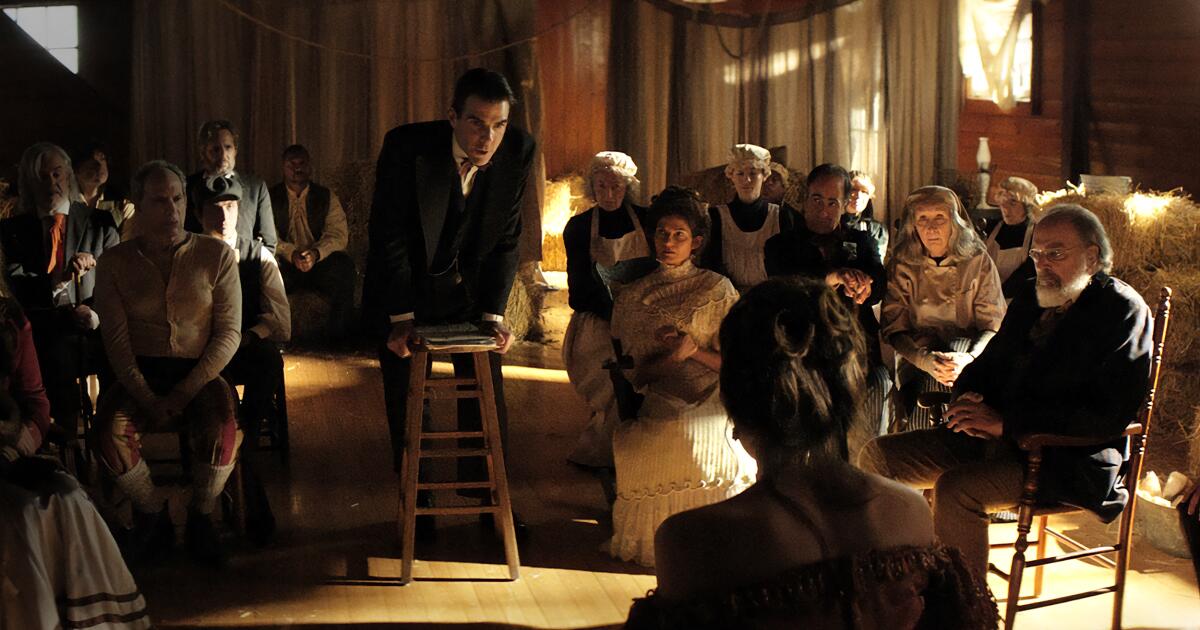
Aram Rappaport’s new six-part comedy, “The Artist,” is available to stream on the Network, a free streaming service he also created to showcase his earlier work, “The Green Veil.” The first three episodes will debut on Thursday, with the final three episodes arriving around Christmas.
One of the first things you notice about this project is its impressive cast – featuring names like Mandy Patinkin, Janet McTeer, Danny Huston, Hank Azaria, Patty Lupone, and Zachary Quinto. This star power naturally leads you to expect a serious and substantial work, but perhaps that’s not the best approach to enjoying it.
The series takes place in 1906 and features fictionalized versions of real historical figures. Much of the story unfolds at the Rhode Island estate of Norman Henry (played by Patinkin), described as a quirky and wealthy businessman – essentially a venture capitalist who appears to be struggling financially. The series begins with a surprising scene: Norman is found dead, wrapped in a carpet and burned like in a Viking funeral. Then, the story flashes back to introduce his wife, Marian (McTeer), who narrates through her diary. She warns the audience that they won’t be able to distinguish truth from fiction, or hero from villain, until the very end. Having only seen the first three episodes, I can’t yet say how accurately the story portrays its real-life inspirations. However, I assume any inaccuracies are simply artistic license, which is perfectly fine.
The staff lives in tents on the front lawn for reasons that aren’t clear, possibly because the house doesn’t have a usable kitchen. They are called inside by bells connected to ropes from the windows, each labeled with a role – Maid, Ballerina, Boxer, Doctor. Lilith, the ballerina (played by Ana Mulvoy Ten), is a young woman mentored by Henry, and naively believes he’ll help her perform “Coppelia” back in Paris. Their interactions are unsettling. We occasionally see her nude, though the scenes are presented artfully, often in a metal tub. Her dance teacher, Marius (David Pittu), is critical and unkind. The boxer serves as Marian’s sparring partner, allowing her to release her anger through boxing. Marian has confided that she despises her husband, and the feeling is mutual, though he claims to love her in a manipulative way.

The show features an artist named Huston, who is eventually revealed to be based on Edgar Degas, the famous French Impressionist painter. However, the show takes significant liberties with his life – Degas was never in Rhode Island in 1906, nor did he paint French poodles! While viewers can draw connections between the show’s ballerina and Degas’s famous paintings, and the nude scenes with his depictions of bathing women, the character bears little resemblance to the real Degas. This version of Degas appears somewhat unstable, possibly drunk or just eccentric, and is very focused on getting paid – a perfectly understandable concern.
Today’s events bring Thomas Edison (Azaria) to the house, seeking funding for his latest creation – the Kinetophone, an early version of virtual reality with sound. (It wasn’t a hit, historically.) This sparks a flashback revealing a past connection between Marian and Edison, and a betrayal he committed against her. We also see Evelyn Nesbit (Ever Anderson) and her mother (Jill Hennessy) fleeing New York after Evelyn’s volatile husband, Harry K. Thaw (Clark Gregg), shot architect Stanford White at a restaurant atop White’s Madison Square Garden – a real event that actually happened.
The show is intense and often chaotic, filled with yelling and bursts of violence – sometimes comical, but often disturbing. It features a lot of unnecessary swearing, with frequent use of strong language and crude sexual references. Everyone seems on edge and ready to explode. From the start, the show is presented not as a typical story, but as a warning about renewal, specifically Marian’s personal transformation. A strong feminist theme runs throughout, portraying men as controlling and women as finding ways to cope – whether by adapting, deceiving, or fighting back – while still maintaining their own identities.
It’s easy to understand why this series might have been difficult to sell to other networks, or why Rappaport wanted complete creative control. The show feels like a throwback to the quirky, absurdist comedies of the late 60s and early 70s – think Robert Downey Sr. or William Klein, or a really ambitious student film with a generous budget and talented cast. It’s surprisingly direct and lacks nuance, which makes it feel quite dated. It’s not necessarily good or bad, but it perfectly captures the creator’s vision, and there’s something admirable about that. The final three episodes, featuring Lupine and Quinto in currently unknown roles, could potentially change how the series is received. Ultimately, it’s a unique show, and you don’t see things like this very often.
Read More
- Mobile Legends: Bang Bang (MLBB) Sora Guide: Best Build, Emblem and Gameplay Tips
- Brawl Stars December 2025 Brawl Talk: Two New Brawlers, Buffie, Vault, New Skins, Game Modes, and more
- Clash Royale Best Boss Bandit Champion decks
- Best Hero Card Decks in Clash Royale
- Call of Duty Mobile: DMZ Recon Guide: Overview, How to Play, Progression, and more
- Clash Royale December 2025: Events, Challenges, Tournaments, and Rewards
- Best Arena 9 Decks in Clast Royale
- Clash Royale Best Arena 14 Decks
- Clash Royale Witch Evolution best decks guide
- Brawl Stars December 2025 Brawl Talk: Two New Brawlers, Buffie, Vault, New Skins, Game Modes, and more
2025-11-27 14:33